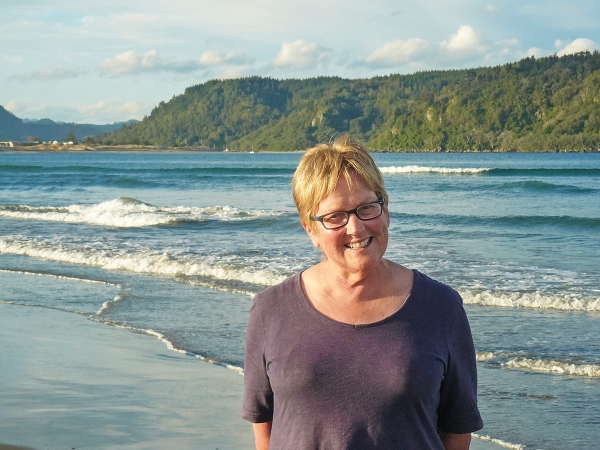Barb Hayden is never far from the sea. In fact, it’s been a constant in her life—a personal and professional passion.
Nature versus nurture—for Barb Hayden life is the culmination of both.
As NIWA’s Chief Scientist – Coasts and Oceans, Barb’s oversees all the important work NIWA’s scientists conduct to enhance understanding and stewardship of perhaps our most important natural resource.
Hers is a deep connection with the sea and one that started at a young age, encouraged by her father.
“My dad should probably be given credit for planting the seed. He had the presence of mind and good taste to buy some land and build a house overlooking the harbour in New Plymouth, where I lived with a daily view of the sea and the comings and goings of the port until I left home to go to university at 17.
“Ngāmotu Beach, next to the port, was walking distance from home and my primary school. Dad was a keen beach-goer, so that’s where I learned to swim and spent my summers.
“Those lazy days at Ngāmotu Beach next to the busy port and with a ‘Nodding Neddy’ on the grass just above the sand quietly pumping oil from New Zealand’s first discovered oil field probably, unwittingly, instilled in me an understanding of the multiple benefits we derive from the sea, and how these activities can and do operate alongside each other. Taranaki is a classic example.”
Fun translated into a career
While the sea was Barb’s childhood constant, it wasn’t until her final year of high school that it dawned on her that she might make it the subject of a career.
“I had an inspiring biology teacher, Mr Hutchinson, who ran fantastic field trips along New Plymouth’s intertidal reefs. Unaware that such fun could translate into a career, I did a technology degree at Massey University, but the call of the sea was answered a couple of years later when I was working at the National Health Institute (now the Institute of Environmental Science and Research, ESR).”
Barb’s role was to help facilitate exports of cultured shellfish, assessing the public health safety of commercial growing areas.
“We set up temporary laboratories in motels, court houses and tents, and assessed microbial water quality in some of New Zealand’s most beautiful and remote coastal spots in Northland, Coromandel and on Waiheke Island. It was like being on holiday every day.”
That experience led to an offer to do marine research fulltime at the Fisheries Research Division of MAF (later to become part of NIWA), as well as a PhD in marine science gained while researching recruitment of mussel spat in Marlborough Sounds. Barb has been with NIWA ever since, appointed Chief Scientist – Coasts and Oceans, based in Christchurch, in 2012.
It’s a role she loves—not only because of the importance of the work NIWA does, but also because of the people she works with.
“New Zealand’s marine estate is certainly special. It covers the ocean and seafloor from the coastal margin to the outer boundaries of the New Zealand’s Exclusive Economic Zone and Extended Continental Shelf and includes the Ross Sea. Within that massive area are globally unique and diverse biota and vast natural resources.
“I like to refer to it as our estate because, just like the common law use of the word, it is New Zealand’s legal marine property, containing natural resources that New Zealand is entitled to use and over which it has obligations of care on behalf of future generations. Therein lies the challenge that most occupies my mind; how best to get the balance right between resource use and effective stewardship.
Gnarly issues: sustainability and biosecurity
“Marine biosecurity and environmentally sustainable resource use have been the two main research threads in my career; both are gnarly issues, but, with good collaboration between resource managers, industry and scientists, New Zealand is tracking well on both issues.”
But it’s the work of all NIWA’s talented scientists that gives Barb most satisfaction.
“Scientists from multiple disciplines, all pitching in together to solve the issues of the day. I am constantly humbled by their smarts. I have the best job.”
And for a marine scientist she possibly has the best partner in life—Barb’s husband is David Schiel, Distinguished Professor of Marine Science at the University of Canterbury. Their two children have left home and, while having not followed their parents into science careers, both have fascinating jobs—one as a conservator of historic architecture and monuments in New York, the other as a mechatronics engineer in San Francisco.
Personal time for Barb and David often involves kicking back and enjoying their bach in Whangamata.
“Whangamata is perfect for switching off. Our bach is simple, with no Internet, and is close enough to the beach that we can enjoy our early morning coffee, sitting on the sand and checking out the surf. In summer, I can be as active as I like or just sit and watch everyone else.
“I love chilling out in Whangamata, even in winter, when most of the holiday homes are empty, the town is quiet and the beach still beautiful—long winter beach walks can’t be beaten for clearing the head.”

